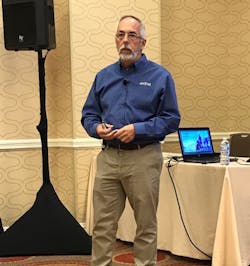The Evolving Role of MES in the Digital Factory
Given its core function of digitizing nearly every aspect of the production process, Manufacturing Execution Systems (MES) are re-emerging as a critical link in the digital transformation of industry. And, just as industry is transforming itself, AVEVA has ensured its MES solutions guide the path on how to effectively meet today’s evolving needs.
At the AVEVA World Conference in Dallas, Tom Troy, director of product management, Manufacturing Execution at AVEVA, explained that the key to this change is AVEVA’s continued refinement of a model-based MES strategy. He described this change as taking place across three functions:
- Digitization—Assess and document current processes in place along with their touch points to other systems (such as automation, laboratory, etc.) to create needed workflows and user interfaces (UIs) that bring them together with AVEVA’s MES and System Platform.
- Standardization—Create a centrally governed library of best practices that define performance metrics and allow for user variations to be built into deployable packages that can be pushed out to multiple sites.
- Improvement—Manage governance of the solution centrally with remote deployment and support to enable continuous improvement of processes based on rich data collection and KPI monitoring.
“What we’re doing differently lies in how we’re delivering our UIs, business processes, rules and automation objects for MES. We’re moving away from fixed models and toward adaptable ones,” Troy said. “We haven’t created a whole new MES, we’ve just changed the experience.”
Troy said this change is based on learning that “certain aspects of an MES [have to] change based on the physical aspects of a plant. We needed to make it easy for users to adopt an out-of-the-box [MES], apply their industrial business processes to it, and deliver standardized MES content [across their operations].”
Though AVEVA’s approach to MES adaptability is changing, Troy stressed two factors that are not changing—the production process model and the information model underlying the MES. How the software works isn’t changing. What’s changing is “how we leverage the workflow model technology to define procedures and collaboration around work execution and data collection, and deliver a configurable UI—since everyone wants something a little different,” said Troy.
Highlighting some of the more prominent customizable facets of a model-based MES, Troy noted that AVEVA’s Skelta BPM (business process management) offers “sophisticated workflow import/export functionality that enables content reuse in multiple application packages, such as work order management, job management, inventory management and performance management. This allowsend users to adapt MES business rules to meet specific operational practices.”
Helping users push these standards out across the plant—to wherever workers may be—is the Adaptive Layouts Form Designer in the model-based MES. “This WYSIWYG, web-based design tool allows for the creation of simple or complex [MES] visualizations that can be previewed across multiple device formats,” Troy said. With this capability, users can ensure information is readily available on any device. “It also has offline capability so that data can be input, even when the device is not connected to the network. Once the device reconnects, that data will get submitted,” he added.

